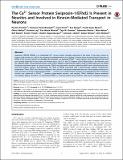Files in this item
The Ca2+ sensor protein Swiprosin-1/EFhd2 is present in neurites and involved in kinesin-mediated transport in neurons
Item metadata
| dc.contributor.author | Purohit, P | |
| dc.contributor.author | Perez-Branguli , F | |
| dc.contributor.author | Prots, I | |
| dc.contributor.author | Borger, Eva | |
| dc.contributor.author | Gunn-Moore, Frank J | |
| dc.contributor.author | Welzel, O | |
| dc.contributor.author | Loy, K | |
| dc.contributor.author | Wenzel, EM | |
| dc.contributor.author | Gromer, TW | |
| dc.contributor.author | Brachs, S | |
| dc.contributor.author | Holzer, M | |
| dc.contributor.author | Buslei, R | |
| dc.contributor.author | Fritsch, K | |
| dc.contributor.author | Regensburger, M | |
| dc.contributor.author | Bohm, KJ | |
| dc.contributor.author | Winner, B | |
| dc.contributor.author | Mielenz, D | |
| dc.date.accessioned | 2014-08-19T11:01:06Z | |
| dc.date.available | 2014-08-19T11:01:06Z | |
| dc.date.issued | 2014-08-18 | |
| dc.identifier | 136465420 | |
| dc.identifier | 6beee6b4-e76d-46b9-aa49-68dfbf150a72 | |
| dc.identifier | 84915821571 | |
| dc.identifier | 000341302700020 | |
| dc.identifier.citation | Purohit , P , Perez-Branguli , F , Prots , I , Borger , E , Gunn-Moore , F J , Welzel , O , Loy , K , Wenzel , EM , Gromer , TW , Brachs , S , Holzer , M , Buslei , R , Fritsch , K , Regensburger , M , Bohm , KJ , Winner , B & Mielenz , D 2014 , ' The Ca2+ sensor protein Swiprosin-1/EFhd2 is present in neurites and involved in kinesin-mediated transport in neurons ' , PLoS One , vol. 9 , no. 8 , e103976 . https://doi.org/10.1371/journal.pone.0103976 | en |
| dc.identifier.issn | 1932-6203 | |
| dc.identifier.other | ORCID: /0000-0003-3422-3387/work/34730427 | |
| dc.identifier.other | ORCID: /0000-0003-4965-2969/work/30767001 | |
| dc.identifier.uri | https://hdl.handle.net/10023/5194 | |
| dc.description | This work was supported by grants from the German Science Foundation (Deutsche Forschungsgemeinschaft, DFG; FOR832, to DM), the German Federal Ministry of Education and Research (01GQ113; to BW), the Bavarian Ministry of Sciences, Research and the Arts in the framework of the Bavarian Molecular Biosystems Reseach Network, the Interdisciplinary Center for Clinical Research (IZKF, Universitatsklinikum Erlangen; E8, to DM; NIII, to BW; Lab rotation to MR), the ELAN Fonds (Universitatsklinikum Erlangen; 11.08.19.1, to IP), and the Alzheimer’s Research UK (EB, FGM). | en |
| dc.description.abstract | Swiprosin-1/EFhd2 (EFhd2) is a cytoskeletal Ca2+ sensor protein strongly expressed in the brain. It has been shown to interact with mutant tau, which can promote neurodegeneration, but nothing is known about the physiological function of EFhd2 in the nervous system. To elucidate this question, we analyzed EFhd2-/-/lacZ reporter mice and showed that lacZ was strongly expressed in the cortex, the dentate gyrus, the CA1 and CA2 regions of the hippocampus, the thalamus, and the olfactory bulb. Immunohistochemistry and western blotting confirmed this pattern and revealed expression of EFhd2 during neuronal maturation. In cortical neurons, EFhd2 was detected in neurites marked by MAP2 and co-localized with preand post-synaptic markers. Approximately one third of EFhd2 associated with a biochemically isolated synaptosome preparation. There, EFhd2 was mostly confined to the cytosolic and plasma membrane fractions. Both synaptic endocytosis and exocytosis in primary hippocampal EFhd2-/- neurons were unaltered but transport of synaptophysin-GFP containing vesicles was enhanced in EFhd2-/- primary hippocampal neurons, and notably, EFhd2 inhibited kinesin mediated microtubule gliding. Therefore, we found that EFhd2 is a neuronal protein that interferes with kinesin-mediated transport. | |
| dc.format.extent | 13 | |
| dc.format.extent | 13624577 | |
| dc.language.iso | eng | |
| dc.relation.ispartof | PLoS One | en |
| dc.subject | QH301 Biology | en |
| dc.subject.lcc | QH301 | en |
| dc.title | The Ca2+ sensor protein Swiprosin-1/EFhd2 is present in neurites and involved in kinesin-mediated transport in neurons | en |
| dc.type | Journal article | en |
| dc.contributor.institution | University of St Andrews. School of Biology | en |
| dc.contributor.institution | University of St Andrews. Institute of Behavioural and Neural Sciences | en |
| dc.contributor.institution | University of St Andrews. Biomedical Sciences Research Complex | en |
| dc.identifier.doi | 10.1371/journal.pone.0103976 | |
| dc.description.status | Peer reviewed | en |
This item appears in the following Collection(s)
Items in the St Andrews Research Repository are protected by copyright, with all rights reserved, unless otherwise indicated.

